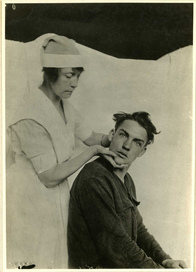- Home
- About Us
- TSPT Academy
- Online Courses
-
Resources
- Newsletter
- Business Minded Sports Physio Podcast
- Day in the Life of a Sports PT
- Residency Corner
-
Special Tests
>
-
Cervical Spine
>
- Alar Ligament Test
- Bakody's Sign
- Cervical Distraction Test
- Cervical Rotation Lateral Flexion Test
- Craniocervical Flexion Test (CCFT)
- Deep Neck Flexor Endurance Test
- Posterior-Anterior Segmental Mobility
- Segmental Mobility
- Sharp-Purser Test
- Spurling's Maneuver
- Transverse Ligament Test
- ULNT - Median
- ULNT - Radial
- ULNT - Ulnar
- Vertebral Artery Test
- Thoracic Spine >
-
Lumbar Spine/Sacroiliac Joint
>
- Active Sit-Up Test
- Alternate Gillet Test
- Crossed Straight Leg Raise Test
- Extensor Endurance Test
- FABER Test
- Fortin's Sign
- Gaenslen Test
- Gillet Test
- Gower's Sign
- Lumbar Quadrant Test
- POSH Test
- Posteroanterior Mobility
- Prone Knee Bend Test
- Prone Instability Test
- Resisted Abduction Test
- Sacral Clearing Test
- Seated Forward Flexion Test
- SIJ Compression/Distraction Test
- Slump Test
- Sphinx Test
- Spine Rotators & Multifidus Test
- Squish Test
- Standing Forward Flexion Test
- Straight Leg Raise Test
- Supine to Long Sit Test
-
Shoulder
>
- Active Compression Test
- Anterior Apprehension
- Biceps Load Test II
- Drop Arm Sign
- External Rotation Lag Sign
- Hawkins-Kennedy Impingement Sign
- Horizontal Adduction Test
- Internal Rotation Lag Sign
- Jobe Test
- Ludington's Test
- Neer Test
- Painful Arc Sign
- Pronated Load Test
- Resisted Supination External Rotation Test
- Speed's Test
- Posterior Apprehension
- Sulcus Sign
- Thoracic Outlet Tests >
- Yergason's Test
- Elbow >
- Wrist/Hand >
- Hip >
- Knee >
- Foot/Ankle >
-
Cervical Spine
>
- I want Financial Freedom
- I want Professional Growth
- I want Clinical Mastery
 This study was released in the March 2013 edition of JOSPT. Anyone who has worked in a physical therapy clinic understands that neck pain is a very common problem. Researchers estimate that as many as 1 in 4 patients in an outpatient PT clinic are referred for neck pain. This specific study by Masaracchio et al assessed the short-term (1 week follow up) effects of adding thoracic spine thrust manipulation in addition to cervical spine Grade III non-thrust P-A mobilizations. 66 participants were randomly selected to either the experimental or control group. Subjects were excluded if they had symptoms distal to the shoulder, pain for >3 months, or a Neck Disability Index score <20%. The subjects in the experimental group who received both the thoracic spine and cervical spine manual therapy had statistically significant changes in their pain as indicated by decreased scores on the Numeric Pain Rating Scale and significantly lower scores on the Neck Disability Index. These results add to the body of literature suggesting the benefits of manual therapy in patients with mechanical neck pain. Different theories exist as to why the thoracic spine manipulation group showed greater improvements. First, there is a clear biomechanical link between the C-spine and T-spine. By moving the thoracic spine, the cervical spine pain generators experience decrease stress. Another explanation discusses changes in mechanoreceptor sensitivity when a thoracic spine thrust manipulation is performed. While thoracic spine manipulation may not have high specificity, several studies have demonstrated that "regardless of the manual therapy intervention chosen, individuals experienced a reduction in pain levels following manual therapy interventions." Some people may argue that this study only assessed patients at 1-week follow up, and it did not investigate long term reductions in pain. With that said, by having the capability to significantly reduce a patients pain in 1-weeks time, you have much more freedom with your intervention selection. Lowering the significance of pain and disability will greatly improve patient satisfaction, patient buy-in, and your ability to prescribe the necessary exercises. To view the full article click here. References:
Masaracchio M, Cleland JA, Hellman M, Hagins M. (2013). Short-Term combined effects of Thoracic spine thrust Manipulation and Cervical spine nonthrust Manipulation in Individuals with Mechanical Neck pan: A Randomized control trial..JOSPT. 2013 March; 43(3): 118-127. Web. 20 September 2013.
1 Comment
Jose Traverso, PT
9/26/2013 12:29:26 am
Just a thought from my clinical point of view. Widespread efects to mobilizations grade V at the cervicothoracic junctions could be related to sympathetic ganglia located... funny how this happens... at the cervicothoracic region, specifically from C7 to T4. Is that weird?
Reply
Leave a Reply. |
Dr. Brian Schwabe's NEW Book in partner with PaleoHacks!
Learn residency-level content on our
Insider Access pages We value quality PT education & CEU's. Click the MedBridge logo below for TSPT savings!Archives
July 2019
Categories
All
|






 RSS Feed
RSS Feed